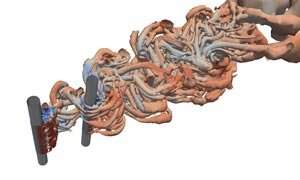Modelling vortices in an ocean current around two cylinders could help marine-offshore engineers design better risers. Credit: A*STAR Institute of High Performance Computing
A*STAR researchers have developed a model that can simulate the complicated forces exerted by flowing water on an array of cylinders supporting water-borne structures such as oil rigs. The work demonstrates the usefulness of numerical simulations to investigate complex physical real-world scenarios.
When designing an off-shore platform, engineers must be able to predict how it will be affected by the motion of the surrounding sea water. As cylindrical structures such as heat exchangers, chimney stacks and riser pipes, are commonly deployed at the point where the platforms enter the ocean, it is vital to understand the forces exerted on them by flowing water under varying sea conditions.
Water flowing around a single cylinder creates oscillating vortices—swirling currents of water. This so-called vortex shedding can cause vibrations in the structure. These typically reach a maximum amplitude when the flow velocity is such that the vortex-shedding oscillation frequency is near the structure's natural mechanical frequency; this is also known as the lock-in frequency.
However, in the case of multiple closely spaced cylinders, interactions between the flows around adjacent cylinders create vibrations as well. The influence of these wake-induced vibrations is poorly understood, and a coherent theory for them has not yet been developed.
Now, Vinh-Tan Nguyen, Wai Hong Ronald Chan and Hoang Huy Nguyen from the A*STAR Institute of High Performance Computing have used a computational fluid dynamics approach to model wake-induced vibrations under various flow conditions.
The team use a numerical model for fluid-structure interactions, which takes into account the coupled effects of vortices on structure responses and vice versa. They tested the reliability of their approach by comparing the numerical prediction with the results of two recent experimental studies. The agreement was reasonably good, and the simulation was able to predict the empirical observation that increased flow velocity leads to higher amplitude vibrations. Notably, unlike in the case of single cylinder, the response amplitude remains large as the flow velocity increases, even away from the lock-in frequency. This phenomenon is a concern for risers deployed in deep sea conditions in a tandem arrangement.
"We are working on a better understanding of those phenomena from a more detailed fluid dynamic perspective," says Vinh-Tan Nguyen. "Ultimately we would like to fully characterize this behaviour and provide an efficient tool for engineers to better design risers and offshore structures in those similar conditions."
More information: Vinh-Tan Nguyen et al. Numerical investigation of wake induced vibrations of cylinders in tandem arrangement at subcritical Reynolds numbers, Ocean Engineering (2018). DOI: 10.1016/j.oceaneng.2018.01.073























